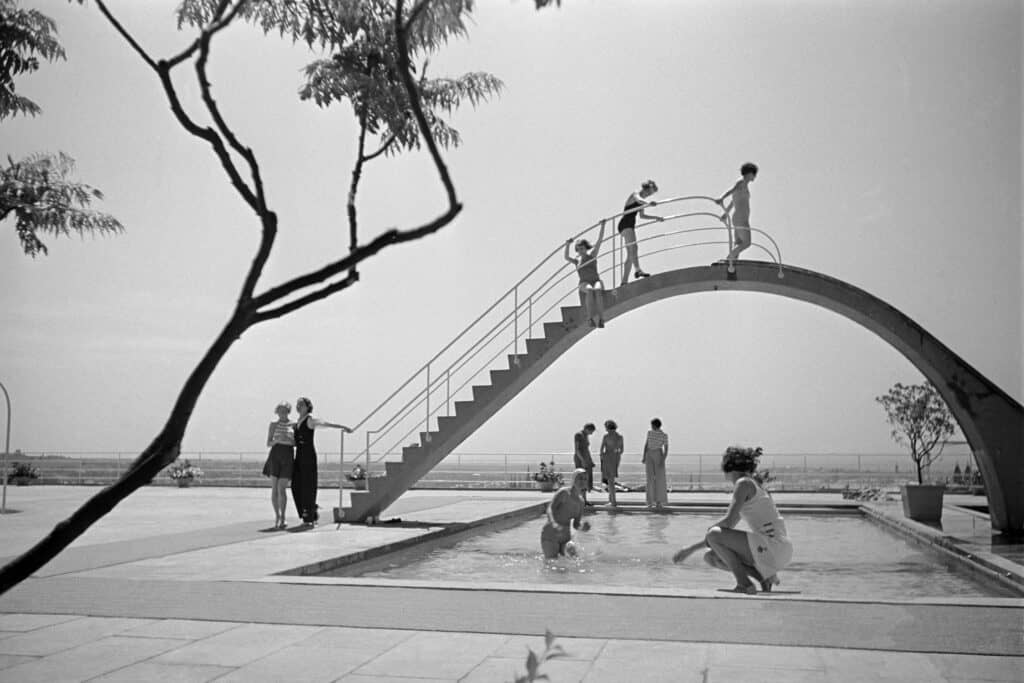Articles and Features
Agents Of Change: Leica.
How The Iconic Camera Changed Photography

Available at Jackson Fine Art, Atlanta, United States
By Adam Hencz
Today, the name Leica is synonymous with quality engineering, innovative design, and the gold standard for personal photography. With its simplicity and compactness, the Leica camera paved the way for all modern photography that benefited from speed, silence and agility: photojournalism, in particular, with war photography as a speciality, but subsequently genres such as fashion when the taboos against less formal photographic styles began to fall. Hundreds of photographers have used their Leica as, in the words of Henri Cartier-Bresson, an “optical extension of the eye”.
From grainy snaps of Oskar Barnack, the inventor of the camera, taken with his primitive prototypes, right up to Henri Cartier-Bresson, Sebastião Salgado, Gary Winogrand, William Eggleston, and dozens of the greatest street and fashion photographers.
The Origins of Leica
The cameras of the 19th century were almost all stuck on a tripod. They had to be, because the negative materials required long exposures and the cameras used large, heavy glass negatives. As film migrated onto flexible supports and the sensitivity of the emulsions was increased, the door was open for small cameras with fast shutter speeds, which could stop action in the slice of time that they recorded. The technology for this change was driven by the invention of movies, which depended upon a rapid sequence of small-format pictures made with very brief exposures.
In 1913, the first successful small format camera was conceived by Oskar Barnack, who initially used the prototype camera to test the exposure for film projectors, but soon realised that the new design had potential as a self-standing still camera. Barnack was an engineer at the Ernst Leitz Optische company based in Wetzlar, Germany, with a desire to create a camera that was more agile and compact than the bulky early 1900s cameras, so difficult to carry around. Barnack was headhunted by Carl Zeiss, became a master technician at the Ernst Leitz company and, for the next ten years, he led the research team that would create multiple prototypes for the Leitz camera, in other words, the Leica.
Changing Photography
Further development was interrupted by the First World War, during which Barnack worked on optional devices for military use. Following the war, in 1920, Leitz decided to press on with the development of Barnack’s camera: Max Berek was brought on to create an appropriate lens for the Leica. Barnack’s photography of the floods in Wetzlar in 1920 is now considered to be the first reportage series shot with a small-format still film camera.

After further experiments, feedback from factory and independent photographers, Ernest Letiz decided to roll out a prototype which would later be called the Leica-I. Presented at the Leipzig Spring Fair in 1925, the Leica-I was an immediate success and was followed by new and improved models. In 1930 the Leica-I Schraubgewinde was created, also known simply as ‘the Leica’. The camera featured a lens that could be replaced as it was screwed in with a 39mm diameter threaded fitting. Whilst the Leica-I was a 35mm fixed-lens camera, Barnack wanted to develop the original further, granting photographers the flexibility to shoot in all manner of conditions. By developing a camera body with detachable and interchangeable lenses, the Leica-II was born. In 1932 came the first Leica camera with a rangefinder, a focusing mechanism which allows the photographer to measure the distance of a subject.
From the very beginning, the Leicas used the same 35mm-width film as the movies did, and used the sprocket holes along both sides to control the position of the film as it was advanced through the camera. The difference was that where this film ran through the movie camera vertically, it ran through the Leica horizontally. The picture format chosen was quite long — the width being half as long again as the height — and this extended rectangle proved to be a great container for the broad and simple forms that the grainy enlargements from miniature film produced. This format became the 35mm standard for photographic film and modern full-frame camera sensors. These small cameras allowed photographers to direct their attention to form rather than detail, and a whole new type of picture structure grew out of their use.
Professional photographers soon realised that the Leica offered them the freedom to shoot dynamically, in extraordinarily high quality. The compact nature of Barnack’s creation allowed photographers to blend into their surroundings and remain discreet while capturing scenes around them. Leica became a favourite model for photojournalists and portrait photographers who wanted to capture intimate moments and get up close to their subjects but also made it easier for amateurs, newcomers, and emancipated women to take pictures.
Taking photography out of the studio and onto the streets, not only did Leica become one of the most prestigious names in photography, but enabled a whole new way of seeing the world.
In 2016, the acclaimed exhibition Eyes Wide Open! 100 Years of Leica celebrated the camera’s 100th anniversary showing more than 200 photographs together with documentary material, camera models and publications from the company archives at Leica.
Relevant sources to learn more
Leica: the camera that freed the world – in pictures – a Guardian article
The Leica camera Blog
Artland Magazine on Photography
Styles of Photography
Five Photography Monographs Everyone Should Know
Cameraless: Adventures In Photography With No Camera
Vivian Maier, Street Photographer
Top American Photographers of the American experience
America 1970s/80s at the Helmut Newton Foundation Berlin
At the Centennial of Helmut Newton’s birth where does his legacy stand today?
Nastassja Kinski & the Serpent



